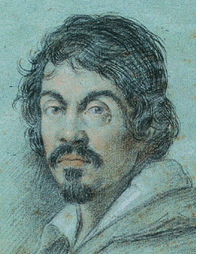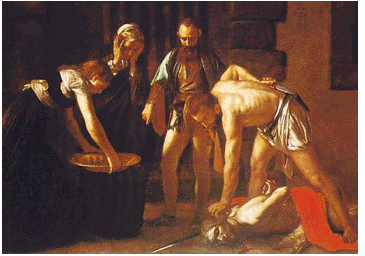...Best of Sicily presents... Best of Sicily Magazine. ... Dedicated to Sicilian art, culture, history, people, places and all things Sicilian. |
by Antonella Gallo | ||
Magazine Index Best of Sicily Arts & Culture Fashion Food & Wine History & Society About Us Travel Faqs Contact Map of Sicily |
He often found himself in trouble. After killing a young man during a brawl in Rome in 1606, he fled the city with a price on his head. In Malta in 1608 he was involved in another brawl, earning him incarceration, and there was a third incident in Naples in 1609, probably rooted in an attempt on his life by unknown assassins. Caravaggio's artistic vision was based on pure, dramatic naturalism expressed in chiaroscuro, the use of light and shadow. To achieve this he painted in a combination of oil and beeswax, modelling figures in middle-range greys before establishing the lights and darks. Unlike many artists, Caravaggio was well-known in his own time. Born into a prosperous Milanese family, Merisi grew up in his mother's
town, Caravaggio (hence his name). Following an apprenticeship in Milan,
he left that city in 1592, having wounded a law oficer during a quarrel.
He soon found work in Rome. Here he met, among others, Mario
Minniti. His work in religious themes was sophisticated, featuring Saint Catherine, Martha and Mary Magdalene, Judith Beheading Holofernes, the Sacrifice of Isaac, Saint Francis of Assisi in Ecstasy, and Rest on the Flight into Egypt. The lesser clergy sometimes thought his work too expressive, common and human, but cardinals, bishops and nobles appreciated it. Finding himself in Naples, and therefore beyond Rome's civil authority, in May 1606 following his (perhaps unintentional) killing of Ranuccio Tomassoni, Caravaggio had no difficulty in finding wealthy patrons, but he felt called farther south. At Malta, working for the knights of Saint John (Order of Malta), he rendered several paintings still retained in Valletta today, including the Beheading of John the Baptist (a detail is shown here). He was invested as a knight of Saint John. In 1608 another brawl landed him in the knights' prison, and he was expelled from the order. Caravaggio managed to escape the fortified city and made his way to Syracuse, where his friend Mario Minniti was living. In Sicily in 1609, he painted the Burial of St. Lucy (now housed in the Santa Lucia Chrch in Siracusa), the Raising of Lazarus, and an Adoration of the Shepherds. Later in the year he was back in Naples, where he painted the Denial of Saint Peter and other works. In Naples Caravaggio survived an attempt on his life. In July 1610 the master died in Tuscany of unknown causes. His legacy lives. About the Author: Antonella Gallo, who teaches art in Rome, has written numerous articles on arts and artists for Best of Sicily. | |
Top of Page |
 By most accounts, Michelangelo
Merisi (1571-1610), known as Caravaggio, was, at the very least, an eccentric
character. However, he is credited with inventing the chiaroscuro ("light and dark") painting
style and is generally considered the first great exponent of the Baroque
school of painting. Unlike many of his contemporaries, who in the wake of
the Renaissance found themselves working in northern Italy with the occasional
venture into Rome, Caravaggio spent his most productive years, from 1593
until his death, from Rome southward to Naples, Sicily and Malta.
By most accounts, Michelangelo
Merisi (1571-1610), known as Caravaggio, was, at the very least, an eccentric
character. However, he is credited with inventing the chiaroscuro ("light and dark") painting
style and is generally considered the first great exponent of the Baroque
school of painting. Unlike many of his contemporaries, who in the wake of
the Renaissance found themselves working in northern Italy with the occasional
venture into Rome, Caravaggio spent his most productive years, from 1593
until his death, from Rome southward to Naples, Sicily and Malta.